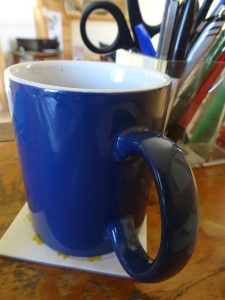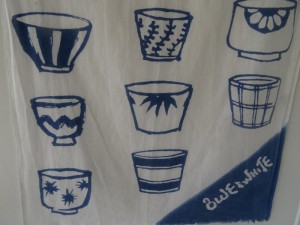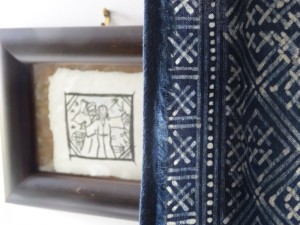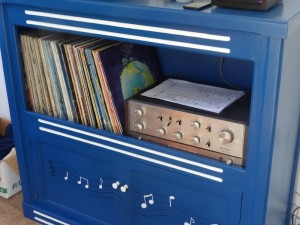Blue is a colour much on my mind right now. But there again I’m not sure it ever quite went away.
It began when my mother said that I ought never to wear blue. This would have been around 1957, in post war Britain.
Having studied fashion illustration at art school, my mother used to entertain my father, my sister and I with a chart hung on the wall explaining the colour wheel. My response, being a wannabe rebellious teenager? To go out and buy some bright blue fabric from the market in Coventry to make a sack dress, a fashion that was all that rage at the time. She was horrified, of course. Not only would the colour “drain me of colour” (her words, not mine), but the shape would “do nothing for me” (ditto). But I did the deed, as in run it up, wore it to jazz clubs and pubs, and thought I looked the bees knees. Being very thin, it’s more likely I resembled a blue bean pole, but let’s not go there.
Through the Sixties and Seventies, family life and my social life tumbled past in a fabulously fast and furious fashion. I was often blue – very blue indeed – as in deeply distressed and depressed. But I worked hard to keep my head above water, and somehow we all survived. The Eighties were another matter. My foundations literally crumbled.
In April 1986, desperate to change my life, I sold my house, apologised to the children and cats who were suddenly out on their own in the world, and went to Japan. Even as the plane soared upwards, away from Margaret Thatcher, the miner’s strike, and a blighted country steeped in blues of its own, I felt the colour change from negativity to positivity. Arriving in first Hong Kong and then Japan, with sky reflected in flooded paddy fields every which way I looked, I quickly understood why blue and white were the colours of Asia.
Fast following on, I learned that indigo (ai) was regarded in craft tradition as a national treasure.
I remember interviewing Amy Katoh of the Blue and White shop in Ebisu (https://blueandwhitetokyo.com/), and her recalling how playing tennis years before on earthen unmade land reclaimed from Tokyo Bay had been a wake up call. She’d realised that under her feet were any number of small pieces of blue and white broken china. I used to walk the beaches of Shonan picking up such remains, and right now have a sack of many hundreds in my garage in Scotland, waiting to be used for something… The general consensus is that ancient trading vessels laden with ceramics between Japan and China must have foundered, with shards still washing up centuries later.
Now Amy’s shop sells all matter of things in blue and white – fabrics, washi paper, ceramics, toys and gifts. It’s very successful too, not with mainstream Japanese who thinks it old-fashioned stuff, but quilt-makers, tourists and odd foreigners like me. A white cushion stitched with pale blue thread (sashiko) sits on our Highland sofa; a tenugui (cloth) printed with blue and white tea cups hangs on a cupboard door in the kitchen.
Our summer dressing gowns, in white cotton dyed with indigo – the true blue of textile dyes, from the leaves of the plant indigofera – are called yukata. Go to any onsen (hotspring) town in Japan and you will see people – especially the elderly – wandering the streets in these traditional bath robes; rather like western women in the Fifties, who felt no shame in wearing their hair in curlers to go shopping.
Quite a few friends in the late Nineties took classes in aizome, dying with indigo.
I have many bits here – curtains made from Thai aizome, bought on travels, the scarf that Rikako gave me; cushions and cards that Catherine made before returning to Canada; a jacket and overshirt made by Tomo (Tomoyuki Tsuji) in Kyoto. Tomo – whom (we heard from his wife) died in 2014 – had a great story, which in memorium I will relate in brief here:
His father had been an artisan indigo dyer, which filled Tomo wih mortification. So old-fashioned he felt as a young man growing up in the 1970s, wanting only to Be American. Escaping to Australia, he was astonished to find people deeply impressed that he came from such a revered city, and highly appreciative of his father’s ancestral calling. He returned to Japan with a new perspective, and uncovering the dye vats (his father had retired) put them to work.
Why did the subject come to mind so suddenly?
Well, Akii has suddenly been taken with the blues. His upcycled music centre is now in place, painted in just the colour he specified. And now he’s waiting for the exterior to be sprayed Cobalt, after hours of mulling over a shade card offering fifty shades of blue.
A second reason is because several pairs of monpe, the Japanese farmers’ trousers that I wear through the summer, are wearing thin. So I ordered three pairs (online, and so easy) from a maker in Kurume, Kyushu. This town on Japan’s southernmost major island and currently in the news, is famed for its kasuri fabrics (from which monpe are made). These involve pre-dying warp threads in indigo in precise mathematical measures prior to weaving. You more probably know the technique as ikat.
No sooner had the monpe arrived than we made the split second decision to go to Japan in May. Our tickets came through the day before the earthquakes in Kyushu began to take their toll…
Right now we feel far from blue, in every sense: physically and psychologically. We could be scared, but we’re not. Having survived Kobe and Fukushima’s 3/11, we know the drill. Packing my suitcase, though, its content will tell a different story. No hard hats and first aid kits (we can buy those on arrival), rather two new T-shirts from Toast (www.toast.co.uk), dyed in indigo naturally.








